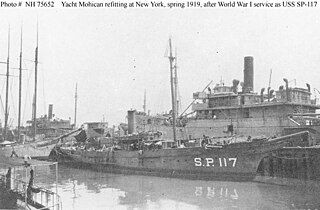
USS Alcedo (SP-166) was a yacht in the United States Navy. She was the first American vessel lost in World War I.
Six ships of the United States Navy have been named USS Kanawha and one has been named USS Kanawha II:

USS Kanawha II (SP-130)/USS Piqua (SP-130) -- was a yacht acquired by the U.S. Navy during World War II. She was placed into service as an escort for Allied convoys traveling across the dangerous North Atlantic Ocean. German U-boats were active in sinking Allied ships, and Kanawha II provided a valuable service as a lookout and in one instance attacked one and drove it off. Post-war she was returned to her pre-war owner in July 1919.

An armed yacht was a yacht that was armed with weapons and was typically in the service of a navy. The word "yacht" was originally applied to small, fast and agile naval vessels suited to piracy and to employment by navies and coast guards against smugglers and pirates. Vessels of this type were adapted to racing by wealthy owners. The origin of civilian yachts as naval vessels, with their speed and maneuverability, made them useful for adaptation to their original function as patrol vessels. In the United States Navy armed yachts were typically private yachts expropriated for government use in times of war. Armed yachts served as patrol vessels during the Spanish–American War and the World Wars. In the latter conflicts, armed yachts were used as patrol vessels, convoy escorts, and in anti-submarine duties. In the United States, yachts were purchased from their owners with the owners given an option to repurchase their yacht at the close of hostilities.

Note: USS Lynx (SP-2) should not be confused with patrol vesselUSS Lynx II SP-730, later USS SP-730, which served in the United States Navy during the same period.

USS Lynx II (SP-730), later USS SP-730, was an armed motorboat that served in the United States Navy as a patrol vessel and harbor dispatch boat from 1917 to 1919.

USS Patrol No. 1 (SP-45), often rendered as USS Patrol #1, was an armed motorboat that served in the United States Navy as a patrol vessel from 1917 to 1919.

USS Patrol No. 5 (SP-29), often rendered as USS Patrol #5, was an armed motorboat that served in the United States Navy as a patrol vessel from 1917 to 1919.

USS Coco (SP-110) was an armed motorboat that served in the United States Navy as a Section patrol vessel from 1917 to 1919.

The third USS Mohican (SP-117), later USS SP-117, was an armed yacht that served in the United States Navy as a patrol vessel from 1917 to 1919.

The first USS Sabalo (SP-225) was a United States Navy patrol vessel in commission from 1917 to 1919. Following World War I, Sabalo was sold to private interests before returning to service as a patrol vessel in World War II, this time with the Royal Canadian Navy, renamed Cougar. Returning to private ownership following the war, the vessel sank in a hurricane in 1950.

The first USS Josephine (SP-913), later USS SP-913, was a United States Navy patrol vessel in commission from 1917 to 1918.

USS Elsie III (SP-708) was a United States Navy patrol vessel in commission from 1917 to 1919 that saw service during World War I. After the completion of her U.S. Navy career, she was in commission in the United States Coast and Geodetic Survey as the survey launch USC&GS Elsie III from 1919 to 1944.

USS City of Lewes (SP-383), later USS Lewes (SP-383), was a minesweeper and patrol vessel that served in the United States Navy from 1917 to 1919.

USS Raeo (SP-588) was a United States Navy patrol vessel in commission from 1917 to 1919. Prior to her U.S. Navy service, she operated as the motor passenger vessel Raeo from 1908 to 1917. After the conclusion of her U.S. Navy career, she served as the fishery patrol vessel USFS Kittiwake in the United States Bureau of Fisheries fleet from 1919 to 1940 and as US FWS Kittiwake in the Fish and Wildlife Service fleet from 1940 to 1942 and from 1944 to at least 1945, and perhaps as late as 1948. During World War II, she again served in the U.S. Navy, this time as the yard patrol boat USS YP-199. She was the civilian fishing vessel Raeo from 1948 to 1957, then operated in various roles as Harbor Queen from 1957 to 1997. She became Entiat Princess in 1998 and as of 2009 was still in service.

The second USS Calypso (SP-632) was a United States Navy patrol vessel in commission from 1917 to 1919. She originally operated as the private motorboat Calypso from 1909 to 1917. After the conclusion of her U.S. Navy career, she served as the fishery patrol vessel in the United States Bureau of Fisheries fleet from 1919 to 1940 as USFS Merganser and in the Fish and Wildlife Service fleet as US FWS Merganser from 1940 to 1942.

USS Katie (SP-660) was a United States Navy patrol vessel in commission from 1917 to 1918.

The first USS Ardent (SP-680) was a United States Navy patrol vessel and minesweeper in commission from 1917 to 1921. Acquired upon the entry of the United States into World War I, the ship served in New England during the war, and was sold back into private ownership in 1921.

USS See W. See (SP-740) was a United States Navy patrol vessel in commission from 1917 to 1919.
USS Jolly Roger (SP-1031) was a United States Navy patrol vessel in commission from December 1917 or early 1918 until November 1918.

















